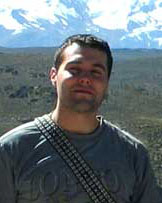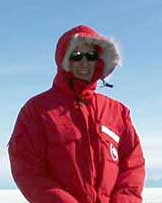Nevado Firura Glacier, Peru
This Project is supported by a generous grant from the
Dan and Betty Churchill Exploration Fund
June 15, 2005 to July 14, 2005


Recent geoarchaeological investigations in the Andes of southern Peru are providing valuable information about the early human settlement of South America, the possible relationship between the highlands and the coast, and adaptation to the ice age environments of this area. Obsidian (volcanic glass) artifacts found at the 13,000 year-old coastal site Quebrada Jaguay by a UMaine team in the 1990s.
Problems in understanding the initial human settlement of South America are linked to gaps in our knowledge of the glacial geologic history of the Andes during the last deglaciation. Thorough geologic mapping and chronological constraint of the glacial record should enable us to address deficiencies in both areas regarding the timing and extent of regional LGM (Last Glacial Maximum) snowline depression, and thus recent evolution of atmospheric circulation over tropical South America, as well as the climatic nature of the last termination. In addition, the fieldwork will provide valuable insight into the existence of a Younger Dryas readvance in southwestern Peru.
 Our field work at the Nevado Firura is also the critical first step in the accurate reconstruction of the local high altitude paleoenvironment. Once we determine the timing and spatial extent of glacial advances and retreats, it will be possible to model other elements of the Terminal Pleistocene and Holocene Andean highland environments, including the distribution and availability of freshwater, biotic communities, and human settlements. Such modelling will be essential for future archaeological research aimed at prehistoric human-ice interactions in the high Andes and other regions. The interdisciplinary expertise and resources of the Climate Change Institute permit us to form the right team for this work, which will contribute to understanding the ways in which climate change affected tropical southern hemisphere glaciation, high elevation Andean environments, and the initial human settlement of the New World.
Our field work at the Nevado Firura is also the critical first step in the accurate reconstruction of the local high altitude paleoenvironment. Once we determine the timing and spatial extent of glacial advances and retreats, it will be possible to model other elements of the Terminal Pleistocene and Holocene Andean highland environments, including the distribution and availability of freshwater, biotic communities, and human settlements. Such modelling will be essential for future archaeological research aimed at prehistoric human-ice interactions in the high Andes and other regions. The interdisciplinary expertise and resources of the Climate Change Institute permit us to form the right team for this work, which will contribute to understanding the ways in which climate change affected tropical southern hemisphere glaciation, high elevation Andean environments, and the initial human settlement of the New World.
For further information, see the project page.
